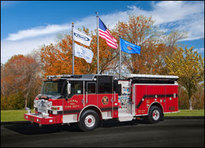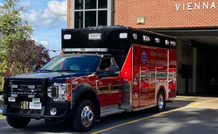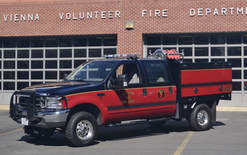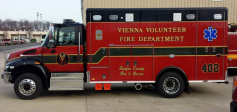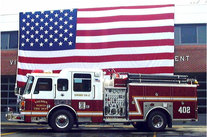Antique.
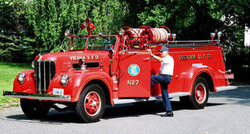
1946 Maxim pumper still serves after six decades
By Vernon Parker
For a fire engine, a 176-inch wheelbase is considered short. The Vienna Volunteer Fire Department for some time had been wanting such a truck, which would be maneuverable in small culs-de-sacs and other tight quarters.
World War II put purchase plans on hold. But on Nov. 8, 1945, less than three months after the fighting ceased, the fire company placed an order with the Maxim Motor Co. in Middleboro, Mass., for a Model 435 fire engine with a 500-gallon-per-minute triple-combination pump and extra equipment in the latest postwar design.
The vehicle was delivered to the Vienna Volunteer Fire Department, inspected, tested and checked against the specifications and accepted by the department Jan. 25,1946. Included in the delivered price of $7,863.48 was various equipment including nozzles, hose adapters, hand extinguishers, first aid kit, gasoline-driven electric generator with four floodlights and vehicle service tools.
The bright red truck, a shade less than 25 feet long, rolled into town on 7.50x20-inch Firestone tires with a gold-leaf "No. 7" on each door.
During most of the war, Sam Savia lived a block from the firehouse and was a teenage volunteer. With most able-bodied men in the military, the fire department ranks were filled with the elderly and the very young.
Toward the end of the war, Mr. Savia graduated from high school and soon found himself in the Army Air Corps. Therefore, he missed the inauguration of No. 7. He returned to Vienna in 1946 and still remembers the first time he drove the new Maxim pumper, double-clutching both up and down the nonsynchronized gears while seated behind the four-spoke, 20-inch diameter wheel.
When the siren at the firehouse wailed, all the volunteers would respond. Because Mr. Savia lived a block away, he usually was first on the scene and, by default more often than not, the driver of No. 7.
The 529-cubic-inch six-cylinder flathead Hercules engine is rated at 135 horsepower.
In addition to the 30-quart-capacity cooling system, dissipation of engine heat is aided by a water-jacket cooler.
The mechanic must bring along a pair of filters and 16 quarts of oil when it is time for a change.
Mr. Savia reports that the huge engine threw off so much heat that even though the cab had no top, it was brutal in the summer. "The two vents on the sides were lifesavers in warm weather," he says.
Mr. Savia recalls a particular response in the early 1950s. Someone in authority had decided that No. 7 should have a speed governor, probably because of the 120-mph speed-ometer. In those pre-electronic days, a governor consisted of a bolt attached to the bottom of the accelerator pedal.
As Mr. Savia was racing as fast as he could to the fire, the head of the bolt slipped through a hole in the floor -- effectively locking the accelerator in place. Disaster was avoided, but only after some white-knuckle maneuvers by Mr. Savia.
He notes that the next week a large washer was attached to the bolt.
Traditionally, fire departments donate or sell surplus equipment to smaller companies, which is what happened to No. 7 after almost a quarter-century of service.
Usually the equipment is gratefully accepted and maintained, but that was not the case for No. 7. Eventually it was literally put out to pasture, where it was found and rescued. Finally, the Ladies Auxiliary of the Vienna Volunteer Fire Department reacquired No. 7 in early 1993 , brought it home and transferred the title back to the Vienna Volunteer Fire Department.
Soon thereafter, restoration began at J&R Body Shop in Winchester.
The renovation was completed in June 1997. With a full 300-gallon tank of water and a full gasoline tank of more than 40 gallons along with a 35-foot extension ladder, an 18-foot roof ladder and 1,000 feet of hose, the engine reportedly weighs about 19,000 pounds. Mileage is estimated at about 6 miles per gallon.
No. 7's firefighting days are history. The engine makes appearances in parades, festivals and holiday events where it is always a crowd-pleaser.
The original four floodlights are gone and No. 7 now has two spotlights as well as a three-light rotary above the windshield.
A pair of cowl light flashers draw attention. On the left front fender is a red wig-wag light. A siren by Sterling fills the spot on the right front fender.
Four men can ride on the 8.75-foot-wide back step.
After almost 60 years, Mr. Savia, long since retired, finds all the necessary skills to operate the No. 7 Maxim are at his command.
Whenever he fires up the Hercules engine, the sound of the exhaust tumbling out of the 3.5-inch pipe is like music to his ears.
By Vernon Parker
For a fire engine, a 176-inch wheelbase is considered short. The Vienna Volunteer Fire Department for some time had been wanting such a truck, which would be maneuverable in small culs-de-sacs and other tight quarters.
World War II put purchase plans on hold. But on Nov. 8, 1945, less than three months after the fighting ceased, the fire company placed an order with the Maxim Motor Co. in Middleboro, Mass., for a Model 435 fire engine with a 500-gallon-per-minute triple-combination pump and extra equipment in the latest postwar design.
The vehicle was delivered to the Vienna Volunteer Fire Department, inspected, tested and checked against the specifications and accepted by the department Jan. 25,1946. Included in the delivered price of $7,863.48 was various equipment including nozzles, hose adapters, hand extinguishers, first aid kit, gasoline-driven electric generator with four floodlights and vehicle service tools.
The bright red truck, a shade less than 25 feet long, rolled into town on 7.50x20-inch Firestone tires with a gold-leaf "No. 7" on each door.
During most of the war, Sam Savia lived a block from the firehouse and was a teenage volunteer. With most able-bodied men in the military, the fire department ranks were filled with the elderly and the very young.
Toward the end of the war, Mr. Savia graduated from high school and soon found himself in the Army Air Corps. Therefore, he missed the inauguration of No. 7. He returned to Vienna in 1946 and still remembers the first time he drove the new Maxim pumper, double-clutching both up and down the nonsynchronized gears while seated behind the four-spoke, 20-inch diameter wheel.
When the siren at the firehouse wailed, all the volunteers would respond. Because Mr. Savia lived a block away, he usually was first on the scene and, by default more often than not, the driver of No. 7.
The 529-cubic-inch six-cylinder flathead Hercules engine is rated at 135 horsepower.
In addition to the 30-quart-capacity cooling system, dissipation of engine heat is aided by a water-jacket cooler.
The mechanic must bring along a pair of filters and 16 quarts of oil when it is time for a change.
Mr. Savia reports that the huge engine threw off so much heat that even though the cab had no top, it was brutal in the summer. "The two vents on the sides were lifesavers in warm weather," he says.
Mr. Savia recalls a particular response in the early 1950s. Someone in authority had decided that No. 7 should have a speed governor, probably because of the 120-mph speed-ometer. In those pre-electronic days, a governor consisted of a bolt attached to the bottom of the accelerator pedal.
As Mr. Savia was racing as fast as he could to the fire, the head of the bolt slipped through a hole in the floor -- effectively locking the accelerator in place. Disaster was avoided, but only after some white-knuckle maneuvers by Mr. Savia.
He notes that the next week a large washer was attached to the bolt.
Traditionally, fire departments donate or sell surplus equipment to smaller companies, which is what happened to No. 7 after almost a quarter-century of service.
Usually the equipment is gratefully accepted and maintained, but that was not the case for No. 7. Eventually it was literally put out to pasture, where it was found and rescued. Finally, the Ladies Auxiliary of the Vienna Volunteer Fire Department reacquired No. 7 in early 1993 , brought it home and transferred the title back to the Vienna Volunteer Fire Department.
Soon thereafter, restoration began at J&R Body Shop in Winchester.
The renovation was completed in June 1997. With a full 300-gallon tank of water and a full gasoline tank of more than 40 gallons along with a 35-foot extension ladder, an 18-foot roof ladder and 1,000 feet of hose, the engine reportedly weighs about 19,000 pounds. Mileage is estimated at about 6 miles per gallon.
No. 7's firefighting days are history. The engine makes appearances in parades, festivals and holiday events where it is always a crowd-pleaser.
The original four floodlights are gone and No. 7 now has two spotlights as well as a three-light rotary above the windshield.
A pair of cowl light flashers draw attention. On the left front fender is a red wig-wag light. A siren by Sterling fills the spot on the right front fender.
Four men can ride on the 8.75-foot-wide back step.
After almost 60 years, Mr. Savia, long since retired, finds all the necessary skills to operate the No. 7 Maxim are at his command.
Whenever he fires up the Hercules engine, the sound of the exhaust tumbling out of the 3.5-inch pipe is like music to his ears.
